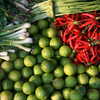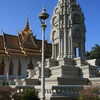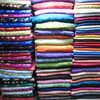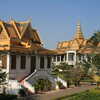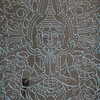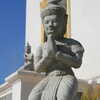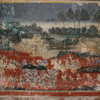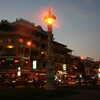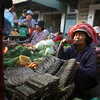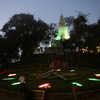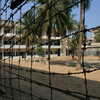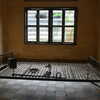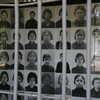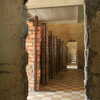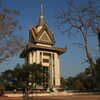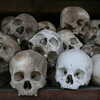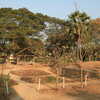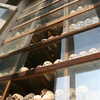Sightseeing in Phnom Penh, Cambodia
After getting over my illness I spent a few days exploring Phnom Penh, including the Royal Palace, Russian Market, Tuol Sleng torture museum and the Killing Fields. Aside from those last couple gruesome and depressing places it’s a really nice city.
Phnom Penh (and the rest of Cambodia) seems to be really booming, so it’s an odd contrast of old and poor and new and rich. You can be walking down a dirty gravel road in the middle of town, then turn a few corners and be in an air conditioned cafe with wireless net access, eating a gourmet sandwich and drinking espresso (expensive by local standards but still half the price it would be at home), with modern lounge music in the background. I don’t think I have seen so many Lexus SUVs in one place before: it seems like people either drive scooters/motorcycles or Lexus SUVs.
I spent most of my time in the area between my guesthouse and the Tonle Sap riverfront area, where I had a few favorite places to eat and work. I also spent a few days doing the obligatory tourist sights, including the Royal Palace and Wat Phnom (temple hill), which is the hill after which Phnom Penh is named; the story is that a lady named Penh deposited four Buddha statues there in the 14th century after finding them in the Mekong River.
One day I went to Psar Tuol Tom Pong, a.k.a. the Russian Market, which is packed with souvenirs, silk, clothes, pirated DVDs, etc. I always thought the cheap brand name clothing you see in Asian markets were all knockoffs and some of them just happened to be better quality than others, but I learned that some of it is the real thing, made in local factories (sweatshops?) belonging to the brand owners. I don’t know how it ends up in the markets: is it all stolen? Or do they allow a small percentage of it to be sold locally? Maybe only the stuff with imperfections?
Anyway, there are some amazing deals to be had — I asked one guy for a price on an authentic North Face backpack (a big one, mountaineering-style), and his first price was $22, so it would probably be $12-15 after haggling, less than 5-10% of its price at home. I considered buying a few packs, filling them with other stuff and shipping them home, but decided it probably wouldn’t be worth the hassle, especially trying to get probably-stolen items past Customs. When I mailed some stuff home from Vietnam they didn’t want to let me send CDs or DVDs out of the country, and they weren’t even pirated — just blank CDs I had brought from home to back up my photos.
Apparently just a few years ago you could buy a lot more at this market: machine guns and ammo, big blocks of hash… that must have been quite a sight to see.
Another day I went to the Tuol Sleng Museum, which is a high school that was converted into a detention and torture center by Pol Pot’s security forces in 1975, named Security Prison 21 (S-21). Between 1975 and 1978 over 17,000 people were held here before being taken to be killed at the Killing Fields — just a small number of the estimated 1.5 million Cambodians who died between 1975 and 1979 as a result of the Khmer Rouge’s policies under Pol Pot’s leadership.
The Khmer Rouge’s goal was to turn the country into a Maoist agrarian cooperative society; upon taking control of Phnom Penh in 1975 they forced everyone out of the cities to work in forced labor camps in the country. Anyone who appeared to be educated (e.g. because they spoke a foreign language, wore glasses or didn’t have callouses on their hands) was tortured and executed.
At the museum were a number of rooms that contained only a rusty bed and a few torture devices, other rooms that had been converted into a series of small prison cells, and a few more rooms with pictures and information about some of the victims.
In the courtyard in the middle there was a piece of equipment formerly used for gymnastics that had been converted into a torture device: prisoners would have their hands bound behind their backs then be strung up by their arms; when they passed out from the pain they would be revived by getting dunked in nasty water nearby before being strung up again.
After Tuol Sleng I continued on to the Killing Fields of Choeung Ek, which has a monument with over 8000 human skulls that were exhumed from mass graves at the site, and a surrounding grassy area with various sites with more information on what had taken place there.
The most disturbing thing for me was the Killing Tree, whose purpose was so heinous I won’t even include it here. I can’t imagine what anyone could possibly say or do to me to make me do such things to other people.
And I couldn’t believe all this stuff happened so recently; where was the rest of the world while this was going on? But similar things continue today in Darfur, and did a few years ago in Rwanda, yet they get no media coverage because mainstream media sucks, and most people are only interested in celebrity gossip.
From Phnom Penh I proceeded north to Siem Reap, home of the amazing temples of Angkor, the main attraction for most visitors to Cambodia.

